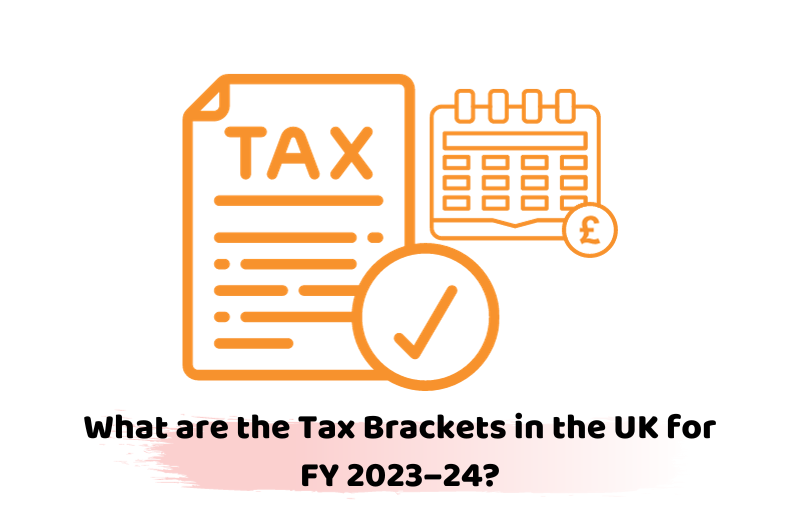Are you trying to figure out your income tax for the current fiscal year? Let’s make it simpler for you. Read this blog till the end to learn about the tax brackets in the UK for FY 2023–2024.
The UK has one of the most complex tax systems in the world. If you are unable to navigate its complexities, you might be fined heavily by the authorities. But don’t worry; in this blog, we will provide you with a list of earnings that are applicable and non-appliable to taxes. In addition, we will provide you with the tax bracket for the ongoing fiscal year. Our aim is to help you plan and file your taxes on time. Let’s begin!
If you require assistance in filing your taxes, get in touch with Accotax!
Earnings Subject to Taxation
Let’s start by clarifying which part of your earnings is applicable to tax:
- Your salary is above the personal allowance rate.
- Profits from self-employment including the services sold through websites and apps.
- Money received through some of the state benefits.
- The government grants to businesses via various financial support schemes.
- Pensions, which include payments from state and private entities.
- Money earned through renting properties.
- Additional benefit payments from your job.
- Your personal income from a trust or a charity.
- Interest earned on savings which crosses the savings allowance.
Earnings Not Subject to Taxation
Following is a list of earnings for which you do not have to pay tax:
- The first £1000 of profit from self-payment (this is your trading allowance)
- The first £1000 of rental income not earned through the rent-a-room scheme.
- Income earned through accounts that are not applicable to taxes (ISAs, etc.)
- Earning from dividends that are under your dividend allowance.
- Some state benefits, such as child benefits, etc.
- Payments received through premium bonds or the National Lottery.
- Rental income that is below the rent-a-room limit.
You might need assistance while filing your taxes; get in touch with a tax advisor now!
What is a Personal Allowance?
There is a term that has repeatedly appeared in the above list: Personal Allowance. Let’s clarify what it means. It is the amount of earnings for which you do not have to pay a tax. Taxes only apply to earnings that are beyond the personal allowance limit and fall into different tax brackets in the UK. The personal allowance for FY 2023–24 is £12,570. However, the limit remains the same even if you change jobs during the year. But this amount remains the same regardless of your age, income, gender, or residence.
Tax Brackets in the UK for 2023–24:
Let’s get to the real part by providing you with the tax brackets in the UK. You need to note that these rates are applicable to earning beyond the personal allowance rate that has been mentioned above.
1. Basic Rate
The basic rate tax bracket is from £12,571 to £50,270 and is subject to 20% tax. This is on the additional earnings above the personal allowance rate. If you are earning, let’s say £30,000, you will be taxed £3,486 which is 20% of the difference between your personal allowance and your income.
2. Higher Rate
If your earnings exceed the bracket of the basic rate, you will be subject to a higher rate for a bracket between £50,271 and £125,140. You will have to pay a 40% tax for any earnings that fall within this limit.
3. Additional Rate
If your earnings exceed the above-mentioned limit, you will fall under the additional rate bracket of £125,140 or more. In this bracket, you will have to pay a 45% tax on your earnings above the mentioned limit.
Is that All the Tax You have to Pay?
We hate to disappoint you, but that’s not all the tax that you have to pay. You will have to navigate the tax structure to know whether you are eligible to pay for other taxes, such as:
- National Insurance Contributions
- Value Added Tax (VAT)
- Council Tax
- Capital Gains Tax (CGT)
- Inheritance Tax (IHT)
The list goes on, and therefore, we recommend hiring a seasoned tax advisor to avoid penalties from the HMRC.
A Quick Wrap-up
The UK has one of the most complex tax structures, which is very hard to navigate. The tax brackets in the UK for FY 2023–24 are ranked on yearly earnings in three categories. The basic rate of 20% applies to earnings from £12,571 to £50,270; the higher rate of 40% applies from £50,271 to £125,140; and the additional rate of 45% applies to earnings beyond £125,140. But that’s not all; there are other taxes that may also be applicable, for which we recommend professional tax advisory services.
Accotax is one of the leading firms providing tax advice. We give you a team of experts who understand the complexities of tax structures to plan and file your taxes ahead of time. Get an instant quote now!





















































